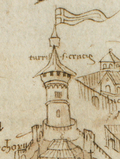Galata Tower
Tower in Istanbul, Turkey From Wikipedia, the free encyclopedia
The Galata Tower (Turkish: Galata Kulesi), officially the Galata Tower Museum (Turkish: Galata Kulesi Müzesi), is a medieval Genoese tower in the Galata part of the Beyoğlu district of Istanbul, Turkey. Built as a watchtower at the highest point of the mostly demolished Walls of Galata,[2] the tower is now an exhibition space and museum, and a symbol of Beyoğlu and Istanbul.
| Galata Tower | |
|---|---|
Galata Kulesi | |
 Galata Tower (September 2023) | |
 | |
| Former names | Christea Turris (Tower of Christ)[1] |
| General information | |
| Type |
|
| Architectural style | Romanesque |
| Location | Istanbul, Türkiye |
| Coordinates | 41°1′32.36″N 28°58′26.96″E |
| Completed | 1348 |
| Renovated |
|
| Owner | Directorate General of Foundations |
| Height | |
| Architectural | 62.59 m (205 ft) |
| Top floor | 40.04 m (131 ft) |
| Dimensions | |
| Diameter | Interior: 8.95 m (29.4 ft) Exterior: 16.45 m (54.0 ft) |
| Technical details | |
| Structural system | Masonry |
| Material | Stone |
| Floor count | 11 (including the basement, the ground floor and the mezzanine) |
| Lifts/elevators | 2 |
| Grounds | 208 m2 (2,240 sq ft) |
History
Summarize
Perspective
During the Byzantine period the Emperor Justinian had a tower erected in what was to become Galata. This tower was destroyed by the Crusaders during the Sack of Constantinople in 1204.
In 1267 a Genoese colony was established in the Galata part of Constantinople. It was surrounded by walls and the Galata Tower was first built at their highest point as the Christea Turris (Tower of Christ) in Romanesque style[1][3] in 1348 during an expansion of the colony. At the time the Galata Tower, at 219.5 ft (66.9 m), was the tallest building in the city.[4]
After the Ottoman conquest of Constantinople in 1453, the Genoese colony was abolished and most of the walls of the citadel were later pulled down in the 19th century, during the northward expansion of the city in the districts of Beyoğlu and Beşiktaş; though small parts of the Genoese walls in Galata have survived.[5][6][7] The tower was allowed to survive and was turned into a prison. It was from its roof that, in 1638, Hezarfen Ahmed Çelebi supposedly strapped on wings and made the first intercontinental flight, landing in the Doğancılar Meydanı in Üsküdar on the Asian side of the city, a story of doubtful authenticity recounted by the Ottoman travel writer, Evliya Çelebi.
From 1717, the Ottomans used the tower to look out for fires (on the Old Istanbul side of the city the Beyazıt Tower served the same function). In 1794, during the reign of Sultan Selim III, the roof was reinforced in lead and wood, but the stairs were severely damaged by a fire. Another fire damaged the building in 1831, after which further restoration work took place.
In 1875, the tower's conical roof was destroyed during a storm.[8][9] It remained without this roof for the rest of the Ottoman period but, many years later, during restoration work between 1965 and 1967, the conical roof was reconstructed.[8][9] At the same time the tower's wooden interior was replaced with a concrete structure and it was opened to the public.[10][11]
In 2020 the Tower was splendidly restored then reopened as a museum now open for the public and the many tourists visiting Istanbul.[12]
It is mainly popular for the 360-degree view of Istanbul visible from its observation deck.
Dimensions
The nine-story tower is 62.59 m (205.3 ft) tall, excluding the ornament on the top. The observation deck is at 51.65 m (169.5 ft). The tower is 61 m (200 ft) above sea-level. It has an external diameter of 16.45 m (54.0 ft) at the base, an inside diameter of 8.95 m (29.4 ft), and walls that are 3.75 m (12.3 ft) thick.
Gallery
- Galata Tower after Cristoforo Buondelmonti, 1420s or 1430s
- Galata Tower after Cristoforo Buondelmonti, late 1480s
- Galata Tower and Pera by Matrakçı Nasuh, 1537
- Galata Tower and Pera by Jérôme Maurand, 1544
- Galata Tower by Paul Lucas, 1720
- Galata Tower by Cosimo Comidas, 1794
- Galata Tower by Antoine Ignace Melling, 1819
- Galata Tower by Augustin François Lemaître, 1840
- Galata Tower by Ivan Aivazovsky, 1846
- Albumen print of the Galata Tower by Pascal Sébah, between 1875 and 1886
- Eastern side
- Galata Tower at night
- Galata Tower, view from Karaköy
See also
References
Further reading
External links
Wikiwand - on
Seamless Wikipedia browsing. On steroids.














